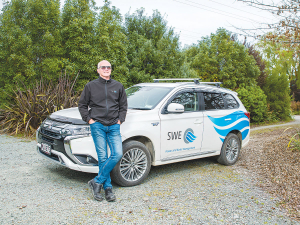In the first year alone, those bikes travelled over 4,500 kilometres - journeys which otherwise would have been made in a petrol or diesel vehicle. We have since made the commitment to purchase company e-bikes for any staff who want one, and a number have taken us up on the offer of an e-bike or a pushbike.
We have also tried to encourage others to try our e-bikes for themselves, to see them as a viable alternative for some journeys. We have organised loans to the Graeme Dingle Foundation Marlborough team, to teachers, clients, and others. Even one of the local vicars is currently riding an SWE e-bike! People are often surprised how quick and easy it is to go by e-bike. Biking from Blenheim's centre to the Riverlands Industrial Estate, 5km away, is often faster than by car. My own travel by e-bike has notched up more than 10,000km since 2017.
When it comes to replacing petrol or diesel vehicles with electric or hybrid models, it's not quite so simple. However, we (like all businesses) used to have a certain way of doing things, and have learned to challenge them. As part of our carbonzero accreditation process we threw out all previous assumptions and looked at everything again with fresh eyes. This has included looking at which work lends itself to using different transportation options.
One example is the contract we have supporting a large client with electrical and technical work located around 60km from SWE headquarters in Blenheim, necessitating approximately 120km of travelling per day. For that work we previously used a ute to transport the staff member and equipment to site. Admittedly, it was working perfectly from a functional point of view. But when we looked at it in terms of emissions, we hoped we could do better. So, with a review of what we transported, and how we structured the job, we were able to get rid of the ute and use a plug-in hybrid electrical vehicle instead. We’ve been tracking and analysing the impact across all our fleet, but with that one change alone we’ve seen a reduction of 44 percent of total energy costs for that work vehicle. That amounts to a reduction of 51 percent of direct emissions, in contrast to the use of a straight petrol or diesel vehicle.
The default thinking was that we needed a ute for that job, and functionally it was great – but environmentally, not so much. And having trialled the hybrid now for a year, we can see with some small changes we were able to make that change work effectively, with no downside to functionality, and a positive environmental upside.
There are some great electric and hybrid vehicles now that have higher clearance, making them more viable for vineyard terrain. But it’s often about thinking bigger than a straight substitute. For example, can you get to site in a different way (vehicle sharing, smaller vehicle, etc) and then if you need to, swap onto a rugged terrain vehicle on site? Can we have ‘pods’ where we store equipment on site to reduce wind drag on vehicles enroute, for example. It’s when we “think bigger” that there’s the opportunity for real innovation and bigger impact.
It’s a bit like our Covid response in some ways. Before Covid struck New Zealand last year, many businesses had never considered how they would work under a lockdown scenario, where most work had to be remote, or in bubbles and so on. In the process, as a nation we had to reconsider how we did almost everything, and there’s been some amazing innovation fall out of that. Well, if we were told tomorrow that our petrol and diesel had run out, or now cost $10 a litre, we’d have to rethink everything too. At SWE we’d rather do that now, instead of wait for the equivalent of an environmental ‘lockdown’ to be announced.
When it comes to reducing our carbon footprint, we are all about the data. As we tell our clients, “you can’t manage what you don’t measure”, so we very much walk the talk on that front and track a huge number of metrics. In terms of transportation, we track distance travelled in every vehicle, vehicle weight and wind drag. We look at fuel economy and driver behaviour, and we cross-reference it against client work, so we understand opportunities to do better.
Reducing fuel consumption and carbon emissions from our work vehicles is only one aspect of what we track and work on. We have nine active “shift projects” and another half dozen already completed, that shift SWE from its current emissions output to a reduced one. They shift us from where we are now, to a place that better meets our mission. An example of another active shift project is to have zero waste to landfill.
In 2019 we set a company goal to reduce our carbon emissions by 80 percent, against base year level, by 2030. So far, we are tracking to meet that goal, but we fully acknowledge we have work to do, and more to learn. It’s not just something we pay lip service to either. Environmental sustainability is a core value included in our mission statement. Consideration is given to environmental practices within SWE, and the impact it can have on clients’ environmental sustainability.
It’s written into our strategic plan, and we evolved a company ‘quadrant’ by which we constantly measure our performance in four key areas. We are so serious about this commitment that we focus on it throughout each year, followed by a formal annual review with which we report back to our Board of Directors on our performance across all four cornerstones of our quadrant.
Stephen is Managing Director of SWE, a Marlborough-based specialist in water engineering, electrical and automation solutions and irrigation. SWE became Toitū carbonzero certified in 2017.



